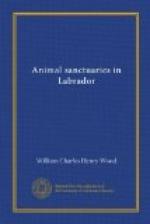the lakes. Big and Little Seal lakes are more
than 100 miles from the nearest salt water. The
Ringed seal is locally called “floe rat”
and “gum seal.” It is the smallest
and least valuable of all, and fairly common all round.
The Harp seal is “seal,” in the same way
as cod is “fish.” It has various local
names, five among the French-Canadians alone, but
is specifically known as the Greenland seal.
The young, immediately after birth, have a fine white
coat, which makes them valuable. The herds are
followed on a large scale at the end of the winter
season, which is also the whelping season, and hundreds
of thousands are killed, females and young preponderating.
They are still common along the east and south, but
diminishing steadily, especially in the St. Lawrence.
The Bearded, or “Square-flipper,” seal
is rare in the St. Lawrence and on the Atlantic, but
commoner in Hudsonian waters. It is a large seal,
eight feet long, and bulky in proportion. The
Grey, or Horse-head, seal runs up to about the same
size occasionally and is one of the gamest animals
that swims. It is rare on the Atlantic and not
common anywhere on the St. Lawrence. The “Hoods”
are the largest of all and the lions of the lot.
They run up to 1,000 pounds and over, and sometimes
fourteen feet long. They are rare on the Atlantic
and decreasing along the St. Lawrence, owing to the
Newfoundland hunters. The Walrus, formerly abundant
all round, is now rarely seen except in the far north,
where he is fast decreasing.
Moose may feel their way in by the southwest to an
increasing extent, and might possibly be reinforced
by the Alaskan variety. Red deer might possibly
be induced to enter by the same way in fair numbers
over a limited area. The woodland caribou is almost
exterminated, but might be resuscitated. The
barren-ground caribou is still plentiful in the north,
where most of the herds appear to migrate in an immense
ellipse, crossing from west to east, over the barrens,
in the fall, to the Atlantic, and then turning south
and west through the woods in winter, till they reach
their original starting-point near Hudson bay in the
spring. But this is not to be counted on.
The herds divide, change direction, and linger in
different places. Their tame brother, the reindeer,
is being introduced as the chief domestic animal of
Eastern Labrador, with apparently every prospect of
success. Beaver are fairly common and widely
distributed in forested areas. Other rodents
are frequent—squirrels, musk-rats, mice,
voles, lemmings, hares and porcupines. There
are two bats. Black bears are general; polars,
in the north. Grizzlies have been traded at Fort
Chimo in Ungava, but they are probably all killed
out. The lynx is common wherever there are woods.
There are two wolves, arctic and timber, the latter
now rare in the south. The Labrador red fox is
very common in the woods, and the “white,”
or arctic fox, in the barrens and further south on
both coasts. The “cross,” “silver”




